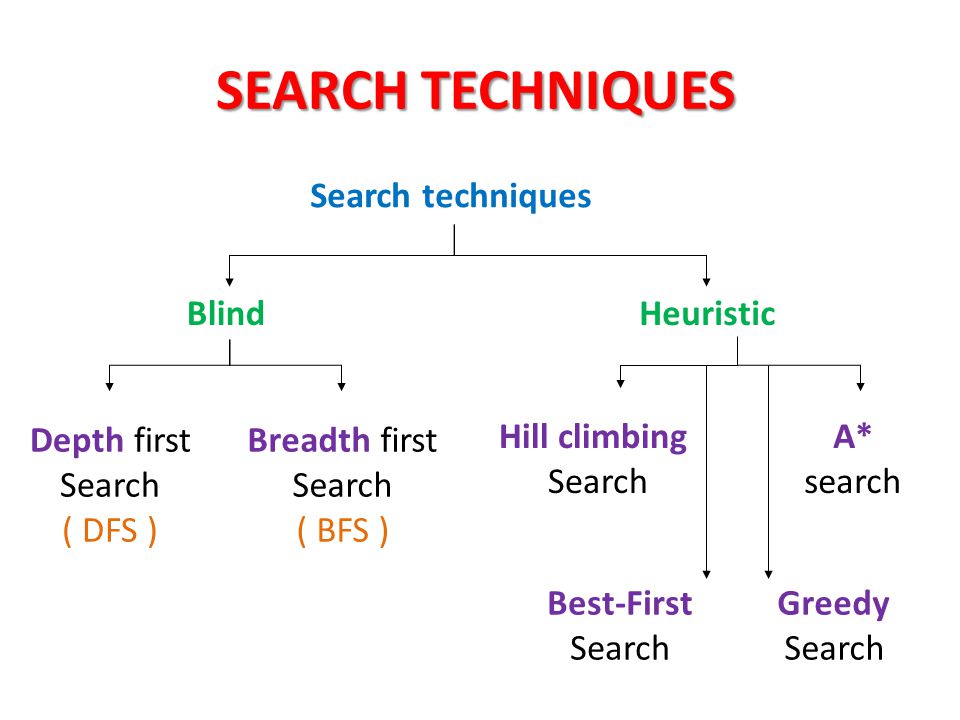It's a method used in AI to solve problems.
The search technique explores the possible moves that one can make in a space of "states" called the search space.
 |
| Fig 1.1 Search Technique |
- Heuristics Search
As the name implies, it uses heuristics to solve problems. This type of search uses domain knowledge.It's often effective but not guaranteed to work in every case.
This type of search does not use any domain knowledge. This means that it does not use any information that helps it reach the goal, like closeness or location of the goal. The strategies or algorithms, using this form of search, ignore where they are going until they find a goal and report success.
Heuristics
Rules about the nature of the problem, which are
grounded in experience and whose purpose is to direct the search
towards the goal so that it becomes more efficient. It usually find a solution close to the best one and they find it fast and easily.
 |
| Fig 1.2 Heuristics |
Fuzzy Logic
Fuzzy logic is an approach to computing based on "degrees of truth" rather than the usual "true or false" (1 or 0) Boolean logic on which the modern computer is based.
 |
| Fig 1.3 Fuzzy Logic |
Fuzzy sets can be considered as an extension and gross oversimplification of classical sets. It can be best understood in the context of set membership. Basically it allows partial membership which means that it contain elements that have varying degrees of membership in the set. From this, we can understand the difference between classical set and fuzzy set. Classical set contains elements that satisfy precise properties of membership while fuzzy set contains elements that satisfy imprecise properties of membership.
Capabilities of AI
Modern MI relies on human intelligence to teach itself then act based on what it learns from the data—the results have been original productions of art, music, speech, poetry, articles, 3D models, and other MI.
High functioning MI uses big data to learn how best to augment human work. Industrial tasks become safer and faster with higher quality output.
Limitations of AI
The system demands huge set of training.
They are programmed with little innate knowledge and possess no common sense about the world or human psychology.
Brittle because when a neural net is given a “transfer test”—confronted with scenarios that differ from the examples used in training—it cannot contextualize the situation and frequently breaks.
Pattern Recognition
Sources
 |
| Fig 1.4 Set Theory |
Capabilities of AI
Modern MI relies on human intelligence to teach itself then act based on what it learns from the data—the results have been original productions of art, music, speech, poetry, articles, 3D models, and other MI.
High functioning MI uses big data to learn how best to augment human work. Industrial tasks become safer and faster with higher quality output.
Limitations of AI
The system demands huge set of training.
They are programmed with little innate knowledge and possess no common sense about the world or human psychology.
Brittle because when a neural net is given a “transfer test”—confronted with scenarios that differ from the examples used in training—it cannot contextualize the situation and frequently breaks.
Pattern Recognition
Sources
- “5.5 Heuristic Algorithms.” Heuristic Algorithms., students.ceid.upatras.gr/~papagel/project/kef5_5.htm.
- “Artificial Intelligence.” Artificial Intelligence RSS, intelligence.worldofcomputing.net/ai-search/heuristic-search.html#.W76AJ2hKhPY.Pontin, Jason. “AI Won't Be Quite the Revolution You Expect.” Wired, Conde Nast, 2 Feb. 2018, www.wired.com/story/greedy-brittle-opaque-and-shallow-the-downsides-to-deep-learning/.
- tutorialspoint.com. “Fuzzy Logic Set Theory.” Www.tutorialspoint.com, www.tutorialspoint.com/fuzzy_logic/fuzzy_logic_set_theory.htm.
- “Capabilities of Artificial Intelligence.” Hypergiant, www.hypergiant.com/capabilities-of-artificial-intelligence/.
No comments:
Post a Comment